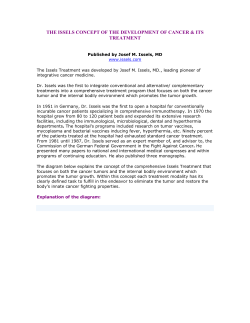
Case Presentation Lindsay R. Rubin, D.O. Wyatt Eye Detroit, MI
Case Presentation Lindsay R. Rubin, D.O. Wyatt Eye Detroit, MI HPI • 51 yo AAM presents for painless, slow growing subcuticular mass of the right upper eyelid • Present for 2 years • Mass caused ptosis and unsatisfactory cosmetic appearance Medical History • • • • All: NKDA Meds: None PMHx: Denies PSHx: Denies • FamHx: HTN, DM II, negative for cancers • SocHx: Occasional MJ • ROS: Negative Exam • Large rubbery, cystic, subcuticular nodule of the right upper eyelid • RUL easily everted revealing normal appearing palpebral conjunctiva • Measured approximately 3.0cm x 2.0cm • Not tender to palpation • No lymph nodes • Remainder of his ocular exam WNL Work Up • CBC w/diff within normal limits • Lytes, BUN, Cr within normal limits Imaging • CT scan of the orbits with and without contrast • Soft tissue mass of the right upper eyelid • Some enhancement with IV contrast suggesting vascular nature Figure 1a. Axial CT image showing well circumscribed mass of the right eyelid. Figure 1b. Coronal CT image of right eyelid mass. Figure 1c. Sagittal CT image Operative Technique • Supraorbital nerve block • RUL was everted, #15 Bard-Parker blade used to make a horizontal incision • Lesion was encapsulated with a cystic component – No capsular rupture • Complete excision • Maxitrol ointment and patch Gross Pathology • Smooth, well-circumscribed encapsulated lesion measuring 3.0 x 2.0 x 1.3 cm • On cut sections, mass had a reddish tan homogenously cut surface with focal dark brown pigmentation along one margin. Microscopic Description • Conjunctival tissue with underlying sharply circumscribed spindle cell vascular stromal tumor • Rare mitotic figures • Scattered lymphocytes and mast cells • Benign mucoserous glands and dilated ducts • No necrosis or hemorrhage Microscopic Description, cont’d • Overlying conjunctiva was intact • Reactive hyperplasia, chronic inflammation of stroma • Pigment laden macrophages • Complete excision • No invasion of surrounding fibrovascular stroma Figure 2a. Low power showing a well circumscribed tumor with intact conjunctiva. Figure 2b. Intermediate power showing solid tumor spindle cell growth. Figure 2c. Higher power (x40) showing spindle cell and multinucleated forms. Figure 1d. High power (x40) showing cellular detail. Immunohistochemical Staining • Tumor cells strongly positive for Vimentin and CD 34 • Cells negative for S100, Melan A, desmin, CD 68 and pankeratin E F Figure 2e,f. Immune stains positive for Vimentin and CD34. Figure 2g. Reticulin stain. Hemangiopericytoma • Rare neoplasms arising from vascular pericytes and post-capillary venules • Originally described by Stout and Murray (1942) – Spindle shaped cells – Staghorn branching pattern • More commonly found in the CNS, retroperitoneum, musculoskeletal system Clinical Course • • • • All ages Men and women equally Benign and aggressive clinical courses Some showing malignant recurrence Management • Natural course of this tumor is unpredictable • Complete surgical excision • Rare mitotic figures raise concern for malignant recurrence • Pt was instructed on self-exam for local recurrence and enlarged lymph nodes A B C Figure 3a,b,c. Post operative images showing complete resection of the tumor, good functional and cosmetic result. Summary • Hemangiopericytomas are rare masses arising from vascular pericytes • Stain CD34 and Vimentin positive • Most are benign • Benign cystic appearing lesion that must be on your differential as it may take an aggressive course References • Abe M, Hara Y, Phnishi Y, Ohno S, Inomata H. Case of primary orbital hemangiopericytoma. Japanese Journal of Ophthalmology 1983; 27:90-95. • Chan WSE, Zhang J, Khong, PL. F-FDG-PET-CT imaging findings of recurrent intracranial haemangiopericytoma with distant metastases. The British Jounral of Radiology. 2010; 83:e172-e174. • Croxatto JO, Font RL. Hemangiopericytoma of the orbit: A clinicopathologic study of 30 cases. Human Pathology 1982; 13:210218. • Fu, ERY, Goh SH, Fong CM. Case report of a primary orbital hemangiopericytoma. Annals of the Academy of Medicine, Singapore. 1993; 22:966-8. • Gengler and Guillou. Solitary fibrous tumor and haemangiopericytoma: evolution of a concept. Hisotpathology 2006; 48:63-74. • Hall WA, Ali AN, Gullett N, Crocker I, Landry JC, Shu H-K, Pabhu R, and Curran W. Comparing central nervous system (CNS) and extra-CNS hemangiopericytomas in the surveillance, epidemiology and end results program. Cancer. 2012; 118:5331-8. • Krishnan M, Kumar sK, Sowmiya T. Hemangiopericytoma—The need for protocol-based treatment plan. Indian J Dent Res 2011;22:497. • Pandey M, Kothari K, Patel D. Haemangiopericytoma: current status, diagnosis and management. European Jounral of Surgical Oncology 1997; 23:282-285. • Schiariti M, Goetz P, El-Maghraby H, Tailor J, Kitchen, N. Hemangiopericytoma: long-term outcome revisited. Journal of Neurosurgery 2011;144:747-755. • Stout AP, Murray MR. Hemangiopericytoma: a vascular tumour featuring Zimmermann’s pericytes. Ann. Surg. 1942; 116:26–33. • Stout AP. Hemangiopericytoma, A study of twenty-five new cases. Cancer 1949;2:1027-1035. Thank you… • Michael Rubin, D.O. • Sidney Simonian, D.O. • Evette Elsenety, M.D.
© Copyright 2025





















